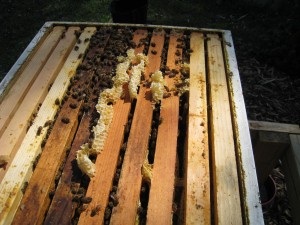Great VSBA Fall Meeting
The Virginia State Beekeepers Association had another great Fall meeting a few weeks ago, focusing on Honey Bee nutrition. The keynote speaker, Dave Mendes (President of the American Beekeepers Federation), focused on protein feeding. To his operation (of many thousands of hives that he trucks to California (Almonds) and the northern states (Blueberries & Cranberries)), feeding protein at the right time makes all the difference. His mantra is ‘good food + clean comb + good genetics = success’. I have long been a proponent of clean comb and good genetics, but have not focused much on nutrition. It has always been my belief that bees with good genetics will find the right food, unless the beekeeper takes it all (which I don’t.) But, I am starting to rethink this idea.
For a couple of years now, a successful beekeeper in Buckingham county that I collaborate with, has been talking up nutrition, specifically in the Fall (which was the theme of a couple of talks at the VSBA meeting.) I have always been reluctant to experiment with this, ONLY because of the SHB. I had found out early on that pollen patties in my hives in August meant SHB problems. But, Dave had an answer for that – you put your feed mix (he called it protein feed, as opposed to pollen feeding) into a wax paper bag with a single slit in it – giving the bees an easy area to defend. He also stressed that you only wanted to give them what they could eat in a couple of days. These two items have me thinking that next Fall I will give protein feeding another shot, in a hive or two. We’ll see how it works.
It only makes sense that giving the bees a source of quality protein at this time (early August for me) would be beneficial. In early August, they are raising the bees that will eventually raise the bees that go into Winter, or what I call the ‘fat bees.’ This is a critical time for all beehives, so a little extra quality feed can help. Dave Mendes recommended the publication ‘Fat Bees Skinny Bees’ by Doug Somerville (sp?), as this seemed to be the basis of his methods.
Another really interesting talk focused on Nosema ceranae. The researcher had found that it appears that this newest Nosema has been around longer then we had thought. In addition, it is starting to look like it is displacing Nosema apis. It’s hard to say whether this is a good thing or not. Regardless, we are seeing an increased presence of this virus, so they are watching it closely.
There was another great talk on feeding, by a fellow along the VA/NC line who focuses on selling bees and queens. He mirrored much of what Dave said, but was even more adamant about the early Fall feeding. He had found that feeding at this time was much better for the bees then any type of feeding in the Spring (syrup or protein) or even feeding during the Winter months. The bottom line was that he found that his bees came out of Winter much healthier with a focused, late Fall feeding. He also noted that the presence of Drones, Drone larva and Drone eggs was a big determinate for feeding protein at other times of the year. Bees with weak protein stores or sources would eat the Drone larva first, then the Drone eggs, for protein. A lack of both of these, in a Spring/Summer hive, was a sign that the quality of the pollen coming in was poor.
There were many other good tidbits of knowledge, but those are the ones that hit home the most for me at this stage. I want to start looking at Fall nutrition. We’ll see where it takes me!

